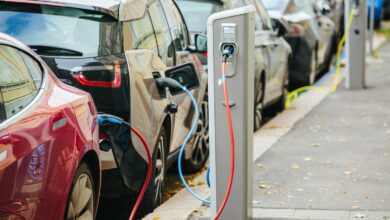Electric vehicle or diesel-powered car — which is better? – DW – 06/17/2024

On the road to a carbon-free future, millions of drivers worldwide are switching to electric cars.
Transportation is responsible for approximately a quarter of the world’s greenhouse gas emissions, and about half of these emissions come from passenger cars.
One way to curb this pollution without giving up driving altogether is to go electric, an idea that’s being touted by some climate advocates as key to combatting climate change.
But they don’t all agree this is the way forward, pointing out that electric vehicles (EVs) also harm the environment.
Since both have an environmental footprint, is it really better to switch to an EV or hold onto a car that still works? Here’s a point-by-point look at how e-cars compare to their conventional counterparts in terms of the environment.
How does the carbon footprint of a combustion car compare to an EV?
Combustion cars and EVs differ significantly in their carbon footprints. Over its lifetime, the combustion car emits 48 tons of carbon dioxide (CO2), which is 40% more than an EV. Those figures come from a comprehensive review by the Transportation Energy Institute in 2021 and assume a car has a lifespan of 320,000 kilometers (around 200,000 miles).
However, EVs actually have a bigger CO2 footprint during the sourcing and production stages. That same review found an EV emitted 11 tons during this first stage, more than double the carbon emitted in making a car with a combustion engine.
How long does it take for an electric vehicle to offset its carbon footprint?
Driving an electric car produces zero emissions, meaning it can pay off its “carbon debt.” Brian Cox, an expert on sustainable mobility from the Swiss consulting company INFRAS, says that in Switzerland, an EV can offset its carbon footprint after 20 to 30,000 kilometers.
“So even if you were to buy a new gasoline or diesel car and then the next day scrap it and buy an electric car, you’re still better off than if you had just driven that diesel car.”
In Germany or the average European country, that carbon offset comes at about 60 to 70,000 kilometers, taking six to seven years, he says. The time varies based on the electricity source, with cleaner energy grids enabling faster offsetting.
Do electric vehicles really not produce any CO2 during the driving stage?
Yes and no. Traditional cars burn fossil fuels, which is why they have an oversized carbon footprint. Car exhaust also causes acid rain, smog and respiratory disease.
EVs don’t burn fossil fuels. Their operation is, in that sense, cleaner because they rely on electricity. However, the overall environmental impact depends on the power grid’s carbon footprint. If the electricity comes from fossil fuels, then charging an EV causes indirect emissions.
“The power system is very complicated and interconnected, so it can be hard to nail those things down,” says Jeremy Michalek, director of the Vehicle Electrification Group at Carnegie Mellon University in the US.
He says energy trading between different regions and countries can also account for apparent discrepancies between carbon footprint studies for electric vehicles.
“Even if the electricity in your country is made from cleaner sources, if you plug in an electric vehicle, it could induce changes in power plants in a neighboring country.”
How much environmental damage is caused by e-car batteries?
Sourcing the materials for EV batteries poses environmental challenges. Lithium, an essential component, has been associated with water depletion and contamination in South America’s “lithium triangle,” where one-third of lithium was mined in 2022.
Mining one ton of lithium requires about 2 million liters of water, enough for roughly 125 electric cars, says Georg Bieker, a senior researcher at the International Council on Clean Transportation. He says that despite this, gasoline production demands 10 times more water over its lifetime.
Cobalt, another key resource, has been linked to habitat destruction and health hazards. In 2022, EVs made up roughly 40% of cobalt demand, and most of it came from the Democratic Republic of Congo.
Cobalt miners are exposed to toxic cobalt particles, which can cause respiratory disease. They also risk exposure to radioactive uranium contained in the ore. Plus, artisanal mining has been linked to child labor and frequent tunnel collapses.
Can e-car batteries be recycled?
Yes, e-car batteries are highly recyclable, but according to Georg Bieker, large-scale recycling probably won’t become widespread until today’s batteries reach the end of their lives in about 15 to 20 years.
“Based on the research, we find that the current battery technology is able to run more than 1,500,000 kilometers (1,000,000 miles),” says Georg Bieker. “We expect that the battery will last much longer than the actual vehicle will be used.”
The market is already moving toward recycling thanks to EU laws mandating the recovery of up to 95% of materials like cobalt and copper and a clause in the US Inflation Reduction Act that incentivizes labeling recycled batteries as “American-made” in exchange for subsidies.
Is there a scenario in which it’s better to keep driving a combustion car?
Yes. One example would be if a car is seldom driven.
“The extra energy that you need to build this battery isn’t really paid off because you don’t drive it very far,” says Brian Cox from INFRAS.
“The better option there would be to use public transit or car sharing. If you can rent an electric car for those few rare times when you need your car and public transit don’t doesn’t work. This is going to be far better than driving your old combustion car.”
Edited by: Tamsin Walker
Sources:
Transportation Energy Institute:
https://www.transportationenergy.org/resources/the-commute/life-cycle-carbon-emissions-of-electric-and-combus
European Commission Directorate-General for the Environment
The International Council on Clean Transportation
https://theicct.org/us-ev-battery-recycling-end-of-life-batteries-sept23/
Listen to the full Living Planet podcast segment on combustion vs e-cars here.



